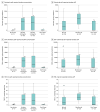Nicotine Exposure From Smoking Tobacco and Vaping Among Adolescents
- PMID: 40072439
- PMCID: PMC11904731
- DOI: 10.1001/jamanetworkopen.2024.62544
Nicotine Exposure From Smoking Tobacco and Vaping Among Adolescents
Erratum in
-
Omission in the Funding/Support Section.JAMA Netw Open. 2025 Aug 1;8(8):e2534609. doi: 10.1001/jamanetworkopen.2025.34609. JAMA Netw Open. 2025. PMID: 40880095 Free PMC article. No abstract available.
Abstract
Importance: It remains unknown whether nicotine intake among youths who vape is lower, comparable, or higher than among youths who smoke.
Objective: To examine potential differences in biomarkers of exposure to nicotine (1) between adolescents who smoke tobacco, vape, both vape and smoke (dual use), or do not use; (2) between adolescents in 3 countries; and (3) by nicotine content and form in the vaping product last used among adolescents who exclusively vaped.
Design, setting, and participants: This population-based, observational cross-sectional study invited adolescents aged 16 to 19 years in Canada, England, and the US who had previously completed national surveys to participate in a biomarker study based on their vaping and smoking status. Participants completed questionnaires and self-collected urine samples between September 2019 and January 2022. Analyses were conducted in February 2023 and between January and June 2024.
Exposures: Vaping, tobacco smoking, dual use, or no use in the past 7 days.
Main outcomes and measures: Urine concentration of cotinine, trans-3'-hydroxycotinine (3OH-cotinine), and total nicotine equivalents (TNE-2; molar sum of cotinine and 3OH-cotinine), normalized for creatinine concentration.
Results: Among the 364 participants (mean [SD] age, 17.6 [1.1] years; 203 females [55.8%]) who provided usable urine samples and completed questionnaires, no differences in TNE-2 concentration were observed between adolescents who exclusively vaped (n = 73; geometric mean [SD], 3.10 [16.69] nmol/mg creatinine), exclusively smoked (n = 68; geometric mean [SD], 3.78 [18.00] nmol/mg creatinine), or both vaped and smoked (n = 77; geometric mean [SD], 6.07 [19.08] nmol/mg creatinine) in the past week, adjusting for creatinine concentration, age, sex, country, and cannabis use. All vaping and/or smoking groups had higher concentrations of TNE-2 than no use (n = 146; geometric mean [SD], 0.19 [1.14] nmol/mg creatinine; P < .001 for all contrasts). Among adolescents who exclusively vaped (n = 73), TNE-2 concentrations were not significantly different between those who reported using products containing more than 20 mg/mL nicotine (n = 33; geometric mean [SD], 4.35 [18.25] nmol/mg creatinine) and containing 20 mg/mL nicotine or less (n = 28; geometric mean [SD], 5.13 [15.64] nmol/mg creatinine). Reported use of vaping products containing nicotine salts (n = 23) was associated with higher concentration of TNE-2 (geometric mean [SD], 10.78 [18.03] nmol/mg creatinine) than reported use of products without nicotine salts (n = 29; geometric mean [SD], 2.72 [15.42] nmol/ng creatinine; P = .03) or reporting "don't know" (n = 14; geometric mean [SD], 1.55 [15.01] nmol/ng creatinine; P = .009). Similar patterns of exposure were observed for cotinine and 3OH-cotinine.
Conclusions and relevance: This cross-sectional study found that vaping was associated with similar nicotine exposure as smoking among adolescents. Reported use of a nicotine salt product was associated with higher nicotine exposure among those who exclusively vaped, consistent with findings from laboratory and population studies indicating greater dependence for nicotine salt e-cigarettes.
Conflict of interest statement
Figures


References
-
- Hiler M, Breland A, Spindle T, et al. Electronic cigarette user plasma nicotine concentration, puff topography, heart rate, and subjective effects: influence of liquid nicotine concentration and user experience. Exp Clin Psychopharmacol. 2017;25(5):380-392. doi: 10.1037/pha0000140 - DOI - PMC - PubMed
-
- WHO Study Group on Tobacco Product Regulation . Report on the scientific basis of tobacco product regulation: seventh report of a WHO study group. WHO Technical Report Series, No. 1015. October 24, 2019. Accessed June 27, 2024. https://www.who.int/publications/i/item/who-study-group-on-tobacco-produ...
-
- UK Office for Health Improvement & Disparities . Chapter 7: biomarkers of exposure. In Nicotine Vaping in England: 2022 Evidence Update Summary. 2022. Accessed February 6, 2023. https://www.gov.uk/government/publications/nicotine-vaping-in-england-20...
Publication types
MeSH terms
Substances
Grants and funding
LinkOut - more resources
Full Text Sources
Medical
Miscellaneous

